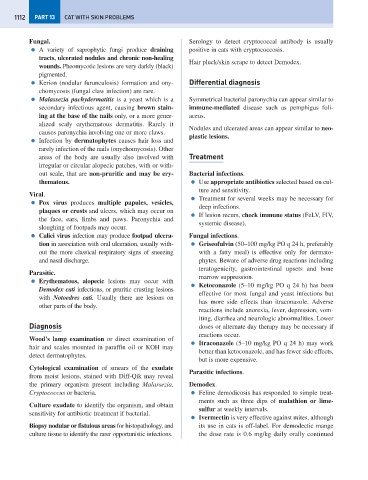Page 1120 - Problem-Based Feline Medicine
P. 1120
1112 PART 13 CAT WITH SKIN PROBLEMS
Fungal. Serology to detect cryptococcal antibody is usually
● A variety of saprophytic fungi produce draining positive in cats with cryptococcosis.
tracts, ulcerated nodules and chronic non-healing
Hair pluck/skin scrape to detect Demodex.
wounds. Pheomycotic lesions are very darkly (black)
pigmented.
● Kerion (nodular furunculosis) formation and ony- Differential diagnosis
chomycosis (fungal claw infection) are rare.
● Malassezia pachydermatitis is a yeast which is a Symmetrical bacterial paronychia can appear similar to
secondary infectious agent, causing brown stain- immune-mediated disease such as pemphigus foli-
ing at the base of the nails only, or a more gener- aceus.
alized scaly erythematous dermatitis. Rarely it
Nodules and ulcerated areas can appear similar to neo-
causes paronychia involving one or more claws.
plastic lesions.
● Infection by dermatophytes causes hair loss and
rarely infection of the nails (onychomycosis). Other
areas of the body are usually also involved with Treatment
irregular or circular alopecic patches, with or with-
out scale, that are non-pruritic and may be ery- Bacterial infections.
thematous. ● Use appropriate antibiotics selected based on cul-
ture and sensitivity.
Viral.
● Treatment for several weeks may be necessary for
● Pox virus produces multiple papules, vesicles,
deep infections.
plaques or crusts and ulcers, which may occur on
● If lesion recurs, check immune status (FeLV, FIV,
the face, ears, limbs and paws. Paronychia and
systemic disease).
sloughing of footpads may occur.
● Calici virus infection may produce footpad ulcera- Fungal infections.
tion in association with oral ulceration, usually with- ● Griseofulvin (50–100 mg/kg PO q 24 h, preferably
out the more classical respiratory signs of sneezing with a fatty meal) is effective only for dermato-
and nasal discharge. phytes. Beware of adverse drug reactions including
teratogenicity, gastrointestinal upsets and bone
Parasitic.
marrow suppression.
● Erythematous, alopecic lesions may occur with
● Ketoconazole (5–10 mg/kg PO q 24 h) has been
Demodex cati infections, or pruritic crusting lesions
effective for most fungal and yeast infections but
with Notoedres cati. Usually there are lesions on
has more side effects than itraconazole. Adverse
other parts of the body.
reactions include anorexia, fever, depression, vom-
iting, diarrhea and neurologic abnormalities. Lower
Diagnosis doses or alternate day therapy may be necessary if
reactions occur.
Wood’s lamp examination or direct examination of
● Itraconazole (5–10 mg/kg PO q 24 h) may work
hair and scales mounted in paraffin oil or KOH may
better than ketoconazole, and has fewer side effects,
detect dermatophytes.
but is more expensive.
Cytological examination of smears of the exudate
Parasitic infections.
from moist lesions, stained with Diff-Qik may reveal
the primary organism present including Malassezia, Demodex.
Cryptococcus or bacteria. ● Feline demodicosis has responded to simple treat-
ments such as three dips of malathion or lime-
Culture exudate to identify the organism, and obtain
sulfur at weekly intervals.
sensitivity for antibiotic treatment if bacterial.
● Ivermectin is very effective against mites, although
Biopsy nodular or fistulous areas for histopathology, and its use in cats is off-label. For demodectic mange
culture tissue to identify the rarer opportunistic infections. the dose rate is 0.6 mg/kg daily orally continued

